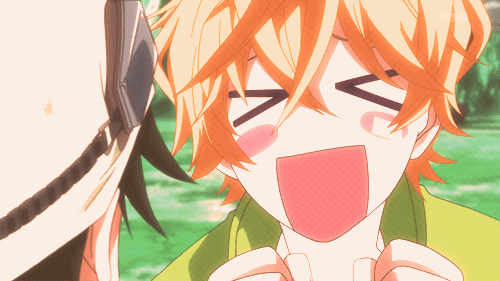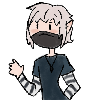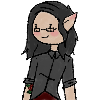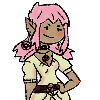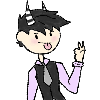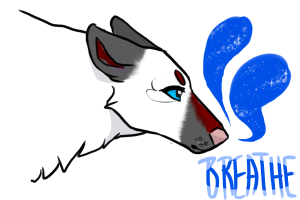
Owned by Folmes
Adopts | Fanclub | Archives


Maned Valehounds are highly intelligent, wolf-like mammals. They live in many diverse climates but prefer northern mountain and forest regions where their thick fur coats allow them protection against the elements. They are typically nomadic and travel in large tribes consisting of many families and overlapping generations. Valehounds are strong, loyal creatures worthy of respect.


Maned Valehounds get their name from the stiff mohawk-like mane running from the base of their skull to their shoulder blades. Their thick fur protects them from the elements and from being injured in fights. Hounds hunt and kill small animal prey but also forage for fruits and tubers. Adults are slightly larger and taller than the average timber wolf while newborn cubs are the size of house cats. Hounds can live for sixty to eighty years old, the oldest being around ninety years.
Valehounds possess incredibly diverse and beautiful coat colors and patterns. They can be dark or light colored and have any kind of color combinations and designs you can imagine. Their coats, which typically coincide with their individual personalities, are designed to help them attract mates, instead of camouflage like other creatures.
Maned Valehounds have several physical mutations that occur randomly in their population and have a small chance of being passed on through their genes.
The most common mutations are:
• Shorter or longer than average tails and manes
• Presence of hair
• Albinism
• Heterochromia
• Presence of stripes or spots on coat
• Presence of snake-like scales on legs, back, and head
• Long fangs or tusks
Rarer mutations include:
• Bioluminescent markings and glowing eyes
• Presence of bone spikes or horns
• Bone plates on back and legs
• Growth of feathers in mane

Maned Valehounds are nomadic and travel in large tribes that can have hundreds of members. Tribes consist of many separate families that work together for protection, food, and finding mates.
Hounds are highly social and intelligent, which has brought about a distinct class system in the tribe society. Everything is based on a system of voting, which requires every Hounds to be active in the society. Members of each class are addressed properly with their titles, otherwise it is considered rude and sometimes outright insulting. Each Hound is considered a single member and does not receive benefits of the ranks of their parents, even the cubs of the leaders. Each starts as a member of the Common collective and earns their rank as they age and participate in the society.
• Tribes are ruled by a single Vale. They are nominated by the tribe and elected by the Council. They rule until deemed unable by the Council.
• An average Council consists of ten members, none of which can be related. They assist the Vale in decision-making, bring conflicts to their attention, and act as liaisons between the Common and the Vale.
• Members of the tribe beneath the Council but held above the Common are: the MendsHound (organizes the healers/menders), GuardsHound (in charge of the guard), and the HuntsHound (leads large hunting parties). There can be several of each of these ranks depending on the size of the tribe.
• The largest rank is the Common, or the Common collective. Its members participate in the hunting or foraging parties, belong to the guard or learn to be healers, and spend their days training in their chosen path.
• Considered very low on the totem pole are the Edgers. They are named because they decided to choose no path, no place in the society, and live on the edges of the tribe. They hunt and fend for themselves and travel behind the clan when migrating. They are generally ignored, not given a say in votes, and not desired at all as mates.
• Loner Valehounds travel without a tribe. They can easily appeal to the Council of a tribe to join the Common.
Though their societies are complex, Valehounds have a simple code. They settle petty fights with honorable combat and punish those who steal, lie, or cheat others. They hold game competitions, learn skills from their elders, and simply try to survive. Tribes can occasionally come into violent war for territory if food is scarce and no agreements can be reached, but they can also collaborate and mingle to find mates or share resources.
Each tribe is unique and has its own customs and traditions. In many tribes, young males go on treks alone through the wilderness for their coming-of-age trial. The goals of the trek may be different (for instance, fast and have a dream-vision, bring back the feather of a rare bird, or simply survive alone), but all males, and sometimes females, must participate to be accepted as adults in the tribe and be eligible for mate-seeking.• Respect all artists, mods, and other users.
• Be congratulatory to winners and don't whine if you lost.
• Do not ask to be an artist or moderator!
• Do not bump this thread for the sake of bumping.
▬▬▬▬▬▬▬▬▬▬▬▬▬▬▬▬▬•☆•▬▬▬▬▬▬▬▬▬▬▬▬▬▬▬▬▬
boxcar
Rakkun
none
(contest to be held later)
Keep up with numbering your designs correctly! Remember in the future we will have babies, but they will take on their numbers when they turn into adults.


- Code: Select all
[IMG]http://i62.tinypic.com/2wqg4lz.gif[/IMG]
By Brandy.

PM me to Affiliate!


other stuff
Species © Echo Base
Species © Holmes & Watson
Lines © Bugabee
Designs © Respective artists






